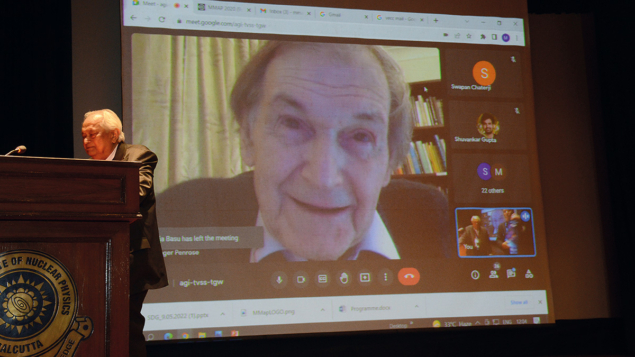
A one-of-a-kind conference MMAP (Macrocosmos, Microcosmos, Accelerator and Philosophy) 2020 was held in May last year in Kolkata, India, attracting 200 participants in person and remotely. An unusual format for an international conference, it combined the voyage from the microcosmos of elementary particles to the macrocosmos of our universe up to the horizon and beyond with accelerator physics and philosophy through the medium of poetry and songs, as inspired by the Indian poet Rabindranath Tagore and the creative giant Satyajit Ray.
The first presentation was by Roger Penrose, who talked about black holes, singularities and conformal cyclic cosmology. He discussed the cosmology of dark matter and dark energy, and inspired participants with the fascinating idea of one aeon going over to another aeon endlessly with no beginning or end of time and space.
Larry McLerran’s talk “Quarkyonic matter and neutron stars” provided an intuitive understanding of the origin of the equation of state of neutron stars at very high density, followed by Debadesh Bandyopadhyay’s talk on unlocking the mysteries of neutron stars. Jean-Paul Blaziot talked about the emergence of hydrodynamics in expanding quark–gluon plasma, whereas Edward Shuryak discussed the role of sphaleron explosions and baryogengesis in the cosmological electroweak phase transition. Subir Sarkar’s talk “Testing the cosmological principle” was provocative, as usual, and Sunil Mukhi and Aninda Sinha described the prospects for string theory. Sumit Som, Chandana Bhattacharya, Nabanita Naskar and Arup Bandyopadhyay discussed the low- and medium-energy physics possible using cyclotrons at Kolkata.
Moving to extreme nuclear matter, Barbara Jacak talked about experimental studies of transport in dense gluon matter. Jurgen Schukraft, Federico Antinori, Tapan Nayak, Bedangadas Mohanty and Subhasis Chattopadhyay spoke on signatures for the early-universe quark-gluon plasma and described the experimental programme of the ALICE experiment at the LHC, and Dinesh Srivastava focussed on the electromagnetic signatures of quark-gluon plasma.
A carnival of ideas, a mixture of low- to high-energy physics on the one hand and the cosmology of the creation of the universe on the other
Amanda Cooper-Sarkar emphasised the role of parton distribution functions in searches for new physics at colliders such as the LHC. Shoji Nagamiya presented the physics prospects of the J-PARC facility in Japan, Paolo Giubellino described the evolution of the latest FAIR accelerator at GSI, and Horst Stöcker discussed how to observe strangelets using fluctuation tools. In his presentation on the history of CERN, former Director-General Rolf Heuer talked about the marvels of large-scale collaboration capturing the thrill of a big discovery.
The MMAP 2020 conference witnessed a carnival of ideas, a mixture of low- to high-energy physics on the one hand and the cosmology of the creation of the universe on the other.








